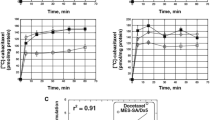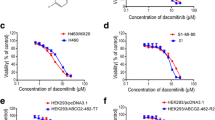Abstract
Multidrug-resistant tumor cells can be resensitized by combined application of the selecting cytostatic drug and a chemosensitizer, such as cyclosporin A (CsA) or a calcium channel blocker. Since clinical trials on the circumvention of multidrug resistance (MDR) with chemosensitizers report disparate results, we investigated whether tumor cells of the MDR phenotype can develop additional resistance to the cytostatic chemosensitizer combination. Thus, the Adriamycin(ADR)-selected, P-glycoprotein-positive MDR Friend leukemia cell line F4-6RADR was exposed to stepwise increased concentrations of CsA at a constant level of 0.05 μg/ml ADR. The initial CsA concentration (plus 0.05 μg/ml ADR) to inhibit cell growth of F4-6RADR cells by 50% (IC50) was 0.04 μg/ml. By continuous incubation for more than 6 months, the IC50 for CsA (at constant ADR) was elevated to 3.6 μg/ml (90-fold), thus generating the variant F4-6RADR-CsA. The F4-6RADR-CsA cells were cross-resistant for cyclosporin H (CsH), a non-immunosuppressive derivative of CsA. As shown by immunocytochemistry as well as by the polymerase chain reaction and by Western blotting including densitometry, P-glycoprotein was preserved in the F4-6RADR-CsA variant and was expressed at a 4-fold higher level than in F4-6RADR cells. Sodium dodecyl sulfate/polyacrylamide gel electrophoresis analysis could detect no new proteins in F4-6RADR-CsA as compared to F4-6RADR. Interestingly, resistance of F4-6RADR-CsA cells remained reversible for the calcium antagonists verapamil and dihydropyridine B859-35 (dexniguldipine-HCl), indicating that CsA and these compounds interfere with the P glycoprotein function by different pharmacodynamic mechanisms. Transport studies with [14C]ADR, performed in the presence and absence of chemosensitizers, confirmed the good correlation of P-glycoprotein function with the pattern of resistance found in proliferation assays. Cellular accumulation of [3H]cyclosporin was reduced to 71% of that of the F4-6 controls in F4-6RADR-CsA cells, but remained at the level of controls in F4-6RADR cells. Results indicate that increased amounts of the P-glycoprotein — besides other, perhaps more important mechanisms that are as yet unknown — partially mediate CsA resistance in F4-6RADR-CsA cells. We have designated this new form of resistance “secondary combined resistance” (SCR). The results suggest that at least some clinical cases of insensitivity to chemosensitizers or of relapse after reversing therapy could be explained by SCR, and that resensitizing treatment of tumor patients should be based on the consideration of several chemosensitizers of different pharmacodynamics.
Similar content being viewed by others
Abbreviations
- ADR:
-
adriamycin
- B859-35:
-
dihydropyridine, proposed
- INN:
-
dexniguldipine-HCI
- CsA:
-
cyclosporin A
- CsH:
-
cyclosporin H
- MDR:
-
multidrug resistance
- PCR:
-
polymerase chain reaction
- SCR:
-
secondary combined resistance
References
Bradford M (1976) A rapid and sensitive method for the quantitation of microgram quantities of protein utilizing the principle of protein-dye binding. Anal Biochem 72:248–253
Broxterman HJ, Pinedo HM, Schuurhuis GJ, Lankelma J (1990) Cyclosporin A and verapamil have different effects on energy metabolism in multidrug-resistant tumour cells. Br J Cancer 62:85–88
Cantwell B, Buamah P, Harris AL (1985) Phase I and II study of oral verapamil and intravenous vindesine. Br J Cancer 52:425–430
Chambers SK, Hait WN, Kacinski BM, Keyes SR, Handschumacher RE (1989) Enhancement of anthracycline growth inhibition in parent and multidrug-resistant Chinese hamster ovary cells by cyclosporin A and its analogues. Cancer Res 49:6275–6279
Dalton WS, Grogan TM, Meltzer PS, Scheper RJ, Durie BGM, Taylor CW, Miller TP, Salmon SE (1989) Drug-resistance in multiple myeloma and non-Hodgkin's lymphoma: detection of P-glycoprotein and potential circumvention by addition of verapamil to chemotherapy. J Clin Oncol 7:415–424
Deuchars KL, Ling V (1989) P-glycoprotein and multidrug resistance in cancer chemotherapy. Semin Oncol 16:156–165
Dietel M (1991) What's new in cytostatic drug resistance and pathology? Pathol Res Pract 187:892–905
Dietel M, Arps H, Klapdor R, Müller-Hagen S, Sieck M, Hoffmann L (1986) Antigen detection by the monoclonal antibodies CA 19-9 and CA 125 in normal and tumor tissue and patients' sera. J Cancer Res Clin Oncol 111:257–265
Dietel M, Arps H, Lage H, Niendorf A (1990) Membrane vesicle formation due to acquired mitoxantrone resistance in human gastric carcinoma cell line EPG85-257. Cancer Res 50:6100–6106
Focus 6∶3 (1984) Bethesda Research Laboratories, Gaithersburg, Md, p 11
Friend C, Partuleia MC, Harven E de (1966) Erythrocytic maturation in vitro of murine Friend virus-induced leukemic cells. J Natl Cancer Inst 22:505–522
Georges E, Bradley G, Gariepy J, Ling V (1990) Detection of P-glycoprotein isoforms by gene-specific monoclonal antibodies. Proc Natl Acad Sci USA 87:152–156
Gros P, Croop J, Housman D (1986) Mammalian multidrug resistance gene: complete cDNA sequence indicates strong homology to bacterial transport proteins. Cell 47:371–380
Handschumacher RE, Harding M, Rice J, Drugge R, Speicher DW (1984) Cyclophilin: a specific cytosolic binding protein for cyclosporin A. Science 226:544–547
Hofmann J, Ueberall F, Egle A, Grunicke H (1991) B-859-35, a new drug with anti-tumor activity reverses multi-drug resistance. Int J Cancer 47:870–874
Höllt V, Kouba M, Dietel M, Vogt G (1993) Stereoisomers of calcium antagonists which differ markedly in their potencies as calcium blockers are equally effective in modulating drug transport by P-glycoprotein. Biochem Pharmacol 43:2601–2608
Hoof T, Riordan JR, Tümmler B (1991) Quantitation of mRNA by the kinetic polymerase chain reaction assay — a tool for monitoring P-glycoprotein gene expression. Anal Biochem 196:162–169
Hu XF, Martin TJ, Bell DR, Luise M de, Zalcberg JF (1990) Combined use of cyclosporin A and verapamil in modulating multidrug resistance in human leukemia cell lines. Cancer Res 50:2953–2957
Kartner N, Evernden-Porelle D, Bradley G, Ling V (1985) Detection of P-glycoprotein in multidrug-resistant cell lines by monoclonal antibodies. Nature 316:820–823
Liu J, Farmer JD Jr, Lane WS, Friedman J, Weissman I, Schreiber ST (1991) Carcineurin is a common target of cyclophilin-cyclosporin A and FKBP-FK506 complexes. Cell 66:807–815
Maniatis T, Fritsch EF, Sambrook J (1982) Molecular cloning. A laboratory manual. Cold Spring Harbor Laboratory, Cold Spring Harbor, NY
Mickisch GH, Kössig J, Keilhauer G, Schlick E, Tschada RK, Alken PM (1990) Effects of calcium antagonists in multidrug resistant primary human renal cell carcinomas. Cancer Res 50:3670–3674
Miller TP, Grogan TM, Dalton WS, Spier CM, Scheper RJ, Salmon SE (1991) P-glycoprotein expression in malignant lymphoma and reversal of clinical drug resistance with chemotherapy plus high-dose verapamil. J Clin Oncol 9:17–24
Milroy R, Connery L, Banham S, Hutcheon A, Macintyre D, Stack B (1987) A randomised trial of verapamil in addition to chemotherapy for small cell lung cancer. Thorax 42:209
Murren JR, Hait WN (1992) Why haven't we cured multidrug resistant tumors? Oncol Res 4:1–6
Naito M, Tsuge H, Kuroko C, Koyama T, Tomida A, Tatsuta T, Heike Y, Tsuruo T (1993) Enhancement of cellular accumulation of cyclosporine by anti-P-glycoprotein antibody MRK 16 and synergistic modulation of multidrug resistance. J Natl Cancer Inst 85:311–316
Osieka R, Seeber S, Pannenbäcker R, Soll D, Glatte P, Schmidt CG (1986) Enhancement of etoposide-induced cytotoxicity by cyclosporin A. Cancer Chemother Pharmacol 18:198–202
Ozols RF, Cunnion RE, Klecker RW, Hamilton TC, Ostchega Y, Parrillo JE, Young RC (1987) Verapamil and Adriamycin in the treatment of drug-resistant ovarian cancer patients. J Clin Oncol 5:641–647
Presant CA, Kenedy PS, Wiseman C (1986) Verapamil reversal of clinical doxorubicin resistance in human cancer. Am J Clin Oncol 9:355–357
Promega (1989) Protocols and application guide. Promega Corporation, Madison, WI
Reymann A, Erttmann KD, Erttmann R, Dietel M (1991) Concentration-response study of chemosensitizers and of their mutual interaction in anthracycline accumulation studies performed in multidrug resistant Friend leukemia cells. Proc Am Assoc Cancer Res 32:378
Reymann A, Looft G, Woermann C, Dietel M, Erttmann R (1993) Reversal of multidrug resistance in friend leukemia cells by dexniguldipine HCl. Cancer Chemother Pharmacol 32:25–30
Rogan AM, Hamilton TC, Young RC (1984) Reversal of Adriamycin resistance by verapamil in human ovarian cancer. Science 224:994–996
Ryffel B, Woerly G, Rodriguez C, Foxwell B (1991) Identification of the multidrug resistance-related membrane glycoprotein as an acceptor for cyclosporine. J Receptor Res 11:675–686
Saeki T, Ueda K, Tanigawara Y, Hori R, Komano T (1993) Human P-glycoprotein transports cyclosporin A and FK506. J Biol Chem 268:6077–6080
Slater LM, Sweet P, Stupecky M, Wetzel MW, Gupta S (1986) Cyclosporin A corrects daunorubicin resistance in Ehrlich ascites carcinoma. Br J Cancer 54:35–238
Sonneveld P, Nooter K (1990) Reversal of drug-resistance by cyclosporin-A in a patient with acute myelocytic leukaemia. Br J Haematol 75:208–211
Steiner JP, Dawson TM, Fotuhi M, Glatt CE, Snowman AM, Cohen N, Snyder SH (1992) High brain densities of the immunophilin FKBP colocalized with calcineurin. Nature 358:584–587
Steinhoff A, Boetefür A, Looft G, Erttmann R (1989) Immunocytochemical detection of p170-glycoprotein in multiple-drug-resistant and superresistant mouse leukemia cells. Naunyn Schmiedeberg's Arch Pharmacol 340:R29
Twentyman PR, Fox NE, White DJG (1987) Cyclosporin A and its analogues as modifiers of adriamycin and vincristine resistance in a multi-drug resistant human lung cancer cell line. Br J Cancer 56:55–57
Weinstein RS, Kuszak JR, Kluskens LF, Coon JS (1990) P-glycoproteins in pathology: the multidrug resistance gene family in humans. Hum Pathol 21:34–48
Werdan K, Lehner K, Cremer T, Stevenson AFG, Messerchmidt O (1990)d-Glucose transport into suspended human fibroblasts. Rapid measurement of uptake by silicone oil filtration centrifugation and comparison of different cell detachment procedures. Hoppe Seyler's Z Physiol Chem 361:91–104
Woodcock DM, Jefferson S, Linsenmeyer ME, Crowther PJ, Chojnowski GM, Williams B, Bertoncello I (1990) Reversal of the multidrug resistance phenotype with cremophor EL, a common vehicle for water-insoluble vitamins and drugs. Cancer Res 50:4199–4203
Author information
Authors and Affiliations
Rights and permissions
About this article
Cite this article
Dietel, M., Herzig, I., Reymann, A. et al. Secondary combined resistance to the multidrug-resistance-reversing activity of cyclosporin A in the cell line F4-6RADR-CsA. J Cancer Res Clin Oncol 120, 263–271 (1994). https://doi.org/10.1007/BF01236382
Received:
Accepted:
Issue Date:
DOI: https://doi.org/10.1007/BF01236382




